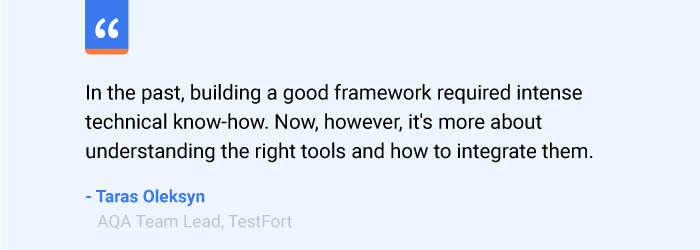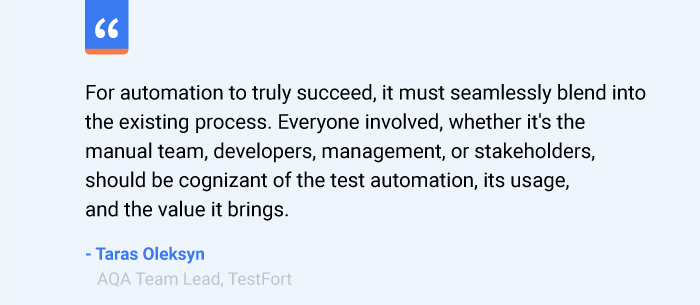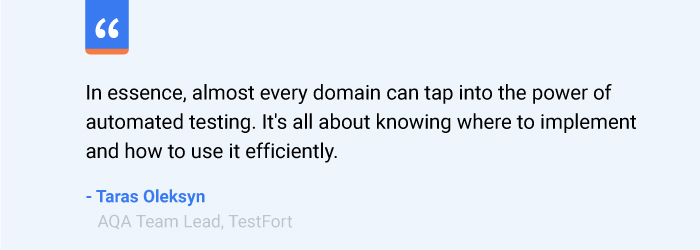Automated testing is playing an indisputable role in software testing. It is replacing manual testing’s repetitive and time-consuming tasks with automated scripts that significantly reduce testing cycles. Embracing automated testing has revolutionized software testing by streamlining processes, enhancing efficiency, and ensuring superior software quality. Automation also accelerates regression testing, uncovering defects early in the development cycle, thus minimizing post-release issues and costs incurred due to these.
Automation in testing enables consistent and repetitive testing, eliminating human errors and enhancing testing efficiency. Moreover, it supports parallel execution, enabling faster feedback on multiple environments, devices, platforms, and configurations.
GoodFirms Roundtable is a series of podcast interview discussions where leading industry experts, CEOs, and people holding prominent positions in IT services and software companies share their valuable experiences and opinions on various topics. The podcast discussion becomes a rich source of information for budding entrepreneurs willing to start their businesses.
GoodFirms recently had a chance to interview Taras Oleksyn, AQA Team Lead, TestFort. In the following podcast discussion, Taras shares his knowledge and views about the importance of automated testing in software testing.
Based in the USA, TestFort is an experienced, end-to-end software testing services provider specializing in full-cycle software testing, including manual testing, automated testing, testing consulting, quality assurance, user experience testing, user interface testing, functionality testing, usability testing, performance testing, compatibility testing, and security testing. With over 22 years of experience in the domain, the company serves numerous clients across the globe, covering all major industries, including healthcare, eCommerce, finance & banking, media & entertainment, and more. The TestFort team leaves no stone unturned to fulfill its commitments towards the clients and deliver high-quality work, on time and within budget.
The Podcast Discussion Highlights the Following:
- Changes in the testing space over the last decade and how testing strategies have changed since technology has evolved.
- How can automated testing be integrated into an existing testing strategy? Are there any best practices or strategies for gradually introducing automation into an established manual testing process?
- Impact of automated testing on the overall collaboration between developers, testers, and other stakeholders involved in the software development lifecycle. What are the potential challenges or adjustments required to foster effective collaboration?
- With the rise of Agile and DevOps practices, how does automated testing fit into the continuous integration and continuous delivery (CI/CD) pipelines? Are there any considerations for incorporating automated tests into these workflows?
- Whether testing automation is required for every software project, or there are situations where it is not recommended. Are there any specific criteria or guidelines to follow to identify the situations where automated testing is required and where it can be avoided?
The Podcast Also Covers These Crucial Points:
- Ethical considerations or potential risks associated with automated testing; whether it can lead to a reduction in human involvement and critical thinking, potentially compromising the quality of the software.
- Case studies and relevant examples of how automated testing benefits various industries and domains.
- Emerging trends and practices in automated testing, like machine learning or AI-driven testing. How will these technologies shape the future of software testing?
- How has TestFort’s experience been so far with GoodFirms?
Today, we are in conversation with Taras, who has 10+ years of experience in the testing industry. So, what are the changes that you have seen in the testing space from the time you came in? How have testing strategies changed since technology has evolved?
Taras explains that around 10 years ago, the testing landscape was very different when they began with automation. Taras also adds that as he initially worked with web UI as an automation engineer, it required them to have significant technical skills to construct an efficient test automation framework. However, with time, newer frameworks emerged. For instance, earlier while using Selenium WebDriver for API testing, testing engineers needed to create a whole framework around it, but with new tools like Selenite and Playwright, most of the challenges of manual testing have been resolved.

Here are some notable changes in the software testing arena due to evolving technologies:
Changes in Perception
There has been a major shift in the perspective of companies in software testing over the decade. Earlier, management typically perceived automation as a one-size-fits-all solution, believing that everything should be automated. However, with time and experience, companies have realized that automation is not just a tech-related project and may not require highly skilled specialists for every aspect.
Testing Strategies
UI testing was the most prevalent method in software testing earlier. Today, with a mature toolchain and stack, there are numerous feature-rich and user-friendly tools available for testing, supported by a robust community. Besides, there is a shift in focus from merely tool switching to a more strategic approach to testing, with greater emphasis on compliance with the automation pyramid, including:
- A large volume of unit tests.
- A moderate number of integration tests.
- A minimal set of UI and end-to-end tests.
In summary, over the years, the tools have improved, the required skill level has decreased slightly, and the industry has matured; thus, testing companies can now invest more time in delivering genuine value instead of wasting time on experimenting with tools and building redundant frameworks.

How Can Automated Testing Be Integrated Into an Existing Testing Strategy? Are There Any Best Practices or Strategies for Gradually Introducing Automation Into an Established Manual Testing Process?
Every project has its unique challenges. Here are some important considerations to follow while integrating automation into your existing testing strategy.
Contextual Approach
Different projects and their stages will have different requirements, and the decision to integrate automation must be considered in the specific context of the project.
Project Maturity
If your application is in the early stages of development, with frequent changes to functionality or user interfaces, it is not the right time to introduce automation. Besides, if there is an absence of a clear manual testing process or no key activities have been established, you must first formalize these test cases before going for automation.
Further, for smaller, short-term projects, a robust automation strategy is not needed; leveraging industry-standard tools, building a basic framework, and creating the necessary test scripts would satisfy the testing needs of such projects.
Engage Stakeholders
For mature projects with established processes and formalized test cases, you must first engage with all stakeholders to understand the current issues with manual testing, identify how automation can resolve or mitigate these issues, and determine the existing quality concerns.
Starting With a Smoke Suite
If you already have a defined set of test cases, you can initiate the automation strategy by picking some essential test cases to create an automated smoke test suite, to ensure that the most critical functionalities are working as expected.
Consideration of Project Strategy
If your project employs a behavior driven development (BDD) approach with a Gherkin language, this can be integrated into the automation strategy. However, if you are looking for a framework to be used by manual testers not much familiar with automation, consider building a keyword-driven framework.
In short, engaging stakeholders and understanding the current testing landscape is as critical as ensuring that the chosen approach aligns with the project's overarching strategy.

How Does Automated Testing Impact the Overall Collaboration Between Developers, Testers, and Other Stakeholders Involved in the Software Development Lifecycle? Are There Any Potential Challenges or Adjustments Required to Foster Effective Collaboration?
Though automation has numerous benefits, throwing or suddenly introducing this into the mix can shake things up in the software development lifecycle. automated testing is not limited to scripting tests and watching them run; for best results, it must gel with all the stakeholders of the software development lifecycle. automated testing impacts the dynamics between developers, testers, and the other key players in numerous ways, including:
Integration is Key
Test automation influences the entire project, and thus it cannot just be a side task that only a few are aware of. Moreover, to truly succeed, automation must seamlessly blend into the existing processes. For this, all the stakeholders, including the manual team, developers, management, and others must be made aware of the test automation, its usage, and the value it can bring.
Accessibility and Visibility
Automation results should be readily accessible to all stakeholders; they should be able to easily view reports in just a click. Further, integrating automation into CI/CD pipelines is crucial. Thus, developers must validate their work using these automated tests.
Challenges
Inefficiencies in the manual testing process or broader project processes can negatively impact automation; for example, converting low-quality manual test cases to automation will result in low-quality test scripts.
Another major but common challenge in integrating automation is the desire to automate everything, resulting in inefficiencies. Automating every single thing typically leads to overloading, resulting in increased maintenance and update time, raising costs and reducing the value derived from automation.
In summary, to maximize automation efficiency and value, you need to find that sweet spot of balance in automation versus manual processes by involving all the stakeholders and their opinions.

With the Rise of Agile and DevOps Practices, How Does Automated Testing Fit Into the Continuous Integration and Continuous Delivery (CI/CD) Pipelines? Are There Any Considerations for Incorporating Automated Tests Into These Workflows?
Adopting Agile and DevOps practices has significantly reshaped software development, and automated testing also has a pivotal role in this new arena, especially in CI/CD pipelines that creates a smooth flow from coding to delivery. Here is how automated testing fits into this setup.
In the backdrop of Agile and DevOps, integrating automated testing into the CI/CD pipeline is almost imperative. However, the automated test should naturally fit into your pipeline and provide a smooth, automated flow where you write your code, push your changes, and the app gets built and deployed to a test environment. Then, an automated regression or smoke test kicks in. Besides, while dealing with multiple test environments, you can leverage cascading pipelines where you deploy your changes, and if the automated test gives a thumbs up, the pipeline just rolls on.
It is important to note here that not every automation setup is perfect right out of the gate; for example, triggering a 3-hour regression test for a minor code change can be highly annoying for developers. Thus, to create the right balance, companies must keep the test automation within the CI/CD framework both efficient and meaningful, considering the context and needs of your project.
There Are Many Benefits of Incorporating Automated Testing but Our Audience Wants to Know if Testing Automation Is Required for Every Software Project, or if There Are Situations Where It’s Not Needed. Are There Any Specific Criteria or Guidelines to Follow That Help Us to Understand When Automated Testing Is Required or Not?
Using automation in every job or every software project is not the right strategy, and automated testing is not a one-size-fits-all solution; for example, it is not wise to invest in automation for a tiny project with minimal complexity where good old manual regression testing can serve the purpose. Moreover, certain aspects of testing cannot be automated, for example, usability testing, which due to its subjective nature, still requires considerable human touch.
Automation is necessary and most beneficial in situations where software testers are dealing with repetitive manual regression tests and are investing enormous hours every week on routine tasks. Additionally, automation scales effortlessly; thus, non-functional testing, including performance, load, and stress tests are the ideal use cases for automated testing.

Are There Any Ethical Considerations or Potential Risks Associated With Automated Testing? For Instance, Can It Lead to a Reduction in Human Involvement and Critical Thinking, Potentially Compromising the Quality of the Software?
Every technology comes with its potential pitfalls, risks, and ethical considerations that cannot be ignored; the same applies to automated testing. In the absence of a solid strategy or the right tools, automated testing can turn into a massive time sink without adding any value to the product quality. In such a scenario, human touch in manual testing is essential and irreplaceable; for example, automating a poorly constructed manual test case will just result in a poor automated script.
The ultimate goal of automated testing should be to produce top-quality software products and not just reduce human touch. Software developers must remember that any mistake in the initial test case or the blueprint gets carried through to the script or the final build.

Are There Any Specific Industries or Domains That Can Benefit the Most From Automated Testing, and Why? Also, Industries Like Healthcare or Finance Don’t Have Room for Errors; So, Is Using automated testing in Such Industries Beneficial? Can You Give Some Relevant Examples or Case Studies?
Benefits of automation depend more on the nature and scale of the project rather than the industry itself. Here are some examples to understand this.
Project and Technology
The advantages of automation largely hinge on the type and scale of the project and the technologies employed; for example, a product with a wide user base or a complex architecture, say microservices, can leverage automation efficiently.
Performance-Centric Industries
Automation is perfect for industries like finance where even a millisecond's delay is not affordable. With automated tests, you can simulate peak loads, repeated stress, and ensure the system's resilience, all without human efforts.
Error-Prone Scenarios
A minor software glitch in healthcare can cause incorrect patient diagnosis. Here, automation can help in rigorous and repetitive testing scenarios to ensure enhanced accuracy and no bugs.
Repeatability
In automation, you need to script it once and it can run any number of times without extra effort, making it invaluable for industries requiring constant testing, like eCommerce, travel, and HR platforms.
Almost every domain can leverage the power of automated testing, but eCommerce, finance, healthcare, HR, education, and travel sectors benefit the most from it. To utilize the maximum potential of automated testing, companies must know where to implement it and how to use it efficiently.

Are There Any Emerging Trends or Practices in Automated Testing, Such as Machine Learning or AI-Driven Testing, That You Find Particularly Intriguing? How Do You Envision These Technologies Shaping the Future of Software Testing?
With ever-increasing technological innovations, it's a roller coaster ride for those in the software testing domain. Tools like Chat GPT have already begun to shape discussions and future possibilities. AI-driven methodologies are all set to dominate the automated testing domain, especially in the realm of result analysis. AI will soon be used not only for test execution but also for insightful result interpretation!
However, the benefits of AI in automated testing will depend on how we can harness AI capabilities in creating foundational code, boilerplate setups, and basic frameworks. AI can also aid in generating template codes or even helping humans understand and learn better.
Using these technologies can certainly augment a tester's capabilities and efficiency, but it is still too early to expect these to replace human testers in the foreseeable future. Nevertheless, the collaboration of humans and technologies will introduce an era of enriched, enhanced, and efficient software testing.

We Came to Know That TestFort Turned 22 Quite Recently and It Is a Remarkable Feat to Achieve. So, When Did You Decide to Make GoodFirms a Part of Your Growth Journey, and How Has Been Your Experience So Far?
Indeed, reaching the 22-year mark for TestFort has been a significant milestone for us. Our decision to join forces with GoodFirms was driven by our continuous pursuit to diversify our reach and collaborate with esteemed platforms in the industry.

You can listen to this podcast here.
What’s Next
Automated testing is undeniably the future of software testing. With its ability to expedite testing, enhance accuracy, and bolster overall software quality, it aligns perfectly with the increasing need for improvement and perfection in software development. It ultimately empowers testing teams from the top software testing companies to focus on complex scenarios and exploratory testing, improving the overall testing ecosystem, and allowing organizations to deliver reliable software faster in today’s agile and continuous integration environments.
As the software landscape evolves, automated testing will ensure that testing processes will remain agile, efficient, and adaptable to meet ever-changing needs of the software development market.
You can share your knowledge or experience on our platform on any topic related to IT services. Just drop an email to [email protected].



